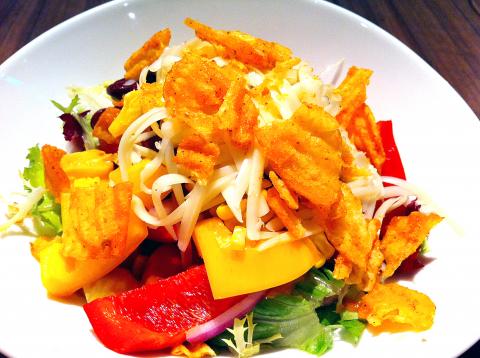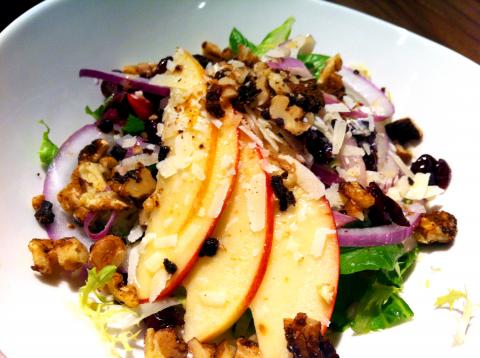The newly opened Mia Cucina is a welcome haven for Taipei’s vegetarians. Located near Sogo Tienmu, the restaurant serves hearty salads, paninis and pasta in an industrial-chic atmosphere. Dishes are designed to encourage sharing: salads, which range in price from NT$320 to NT$380, come in portions large enough to satisfy two hungry diners.
Everything on Mia Cucina’s menu is meat-free and there is also a large selection of vegan offerings. Even diehard carnivores should be able to find something they enjoy. The restaurant’s chefs excel at creating offbeat but thoughtful combinations of sweet and savory flavors, and make sure that each dish has a diverse mixture of textures to keep diners interested until the last bite.
From the starter menu, my companion and I ordered jalapeno rockets (NT$180), or grilled whole peppers stuffed with cheese, almond slices and raisins. The sweet, fat raisins were an unusual and fun complement to the very piquant, mouth-searing jalapenos.

Photo: Catherine Shu, Taipei Times
Though pricey at NT$450, Mia Cucina’s set meal (which changes every two months) is big enough to provide leftovers and allows diners to sample the restaurant’s large array of dishes. Courses include the soup of the day (visit on Sunday or Monday for the delicious coconut pumpkin), salad, main course (either a panini sandwich or pasta), organic tea and dessert.
The cowboy salad (NT$350 a la carte) shows off Mia Cucina’s ability to successfully deploy unlikely ingredients. It is made with grilled corn and bell peppers, red onions, smoked beans, cherry tomatoes, jalapeno jack cheese cubes and avocados topped with barbecue dressing and “tortilla crunchies.” The latter turned out to be barbecue-flavored chips. I was incredulous at first, but they added just the right boost of flavor and crunch to the salad. The strawberry pecan salad (NT$320), featuring strawberries, apples, mango, dried cranberries, cherry tomatoes, caramelized pecans and parmesan topped with an orange vinaigrette dressing, showcases Mia Cucina’s deft hand at creating satisfying and complex dishes from simple ingredients.
My friend’s sweet mustard panini (NT$185) was made from bread studded with dried cranberries and stuffed with apples, caramelized onions, walnuts and mozzarella cheese with sweet mustard. On paper, the combination of ingredients sounds cloyingly sweet. But the tangy mustard offered a contrast to the other ingredients and the walnuts added just the right touch of richness.

Photo: Catherine Shu, Taipei Times
The only disappointing dish we tried at Mia Cucina was the pecan asparagus pasta (NT$350). The spaghetti was slightly overcooked and sticky, but the yummy pesto sauce and large portions of asparagus sprigs and nuts made up for the pasta’s lackluster texture.
My companion said that she’d be happy to return to Mia Cucina just to enjoy the restaurant’s decor. The cavernous space features cement and brick walls accented with blonde wood furnishings and exposed, oxidized metal. A display in the back showcases an array of goods, including notebooks, almond butter and Wallpaper city guides, to browse as you wait for your meal. But you won’t have to wait long: Mia Cucina’s service is as prompt and thoughtful as its culinary offerings.

This month the government ordered a one-year block of Xiaohongshu (小紅書) or Rednote, a Chinese social media platform with more than 3 million users in Taiwan. The government pointed to widespread fraud activity on the platform, along with cybersecurity failures. Officials said that they had reached out to the company and asked it to change. However, they received no response. The pro-China parties, the Chinese Nationalist Party (KMT) and Taiwan People’s Party (TPP), immediately swung into action, denouncing the ban as an attack on free speech. This “free speech” claim was then echoed by the People’s Republic of China (PRC),

Exceptions to the rule are sometimes revealing. For a brief few years, there was an emerging ideological split between the Democratic Progressive Party (DPP) and Chinese Nationalist Party (KMT) that appeared to be pushing the DPP in a direction that would be considered more liberal, and the KMT more conservative. In the previous column, “The KMT-DPP’s bureaucrat-led developmental state” (Dec. 11, page 12), we examined how Taiwan’s democratic system developed, and how both the two main parties largely accepted a similar consensus on how Taiwan should be run domestically and did not split along the left-right lines more familiar in

As I finally slid into the warm embrace of the hot, clifftop pool, it was a serene moment of reflection. The sound of the river reflected off the cave walls, the white of our camping lights reflected off the dark, shimmering surface of the water, and I reflected on how fortunate I was to be here. After all, the beautiful walk through narrow canyons that had brought us here had been inaccessible for five years — and will be again soon. The day had started at the Huisun Forest Area (惠蓀林場), at the end of Nantou County Route 80, north and east

Specialty sandwiches loaded with the contents of an entire charcuterie board, overflowing with sauces, creams and all manner of creative add-ons, is perhaps one of the biggest global food trends of this year. From London to New York, lines form down the block for mortadella, burrata, pistachio and more stuffed between slices of fresh sourdough, rye or focaccia. To try the trend in Taipei, Munchies Mafia is for sure the spot — could this be the best sandwich in town? Carlos from Spain and Sergio from Mexico opened this spot just seven months ago. The two met working in the